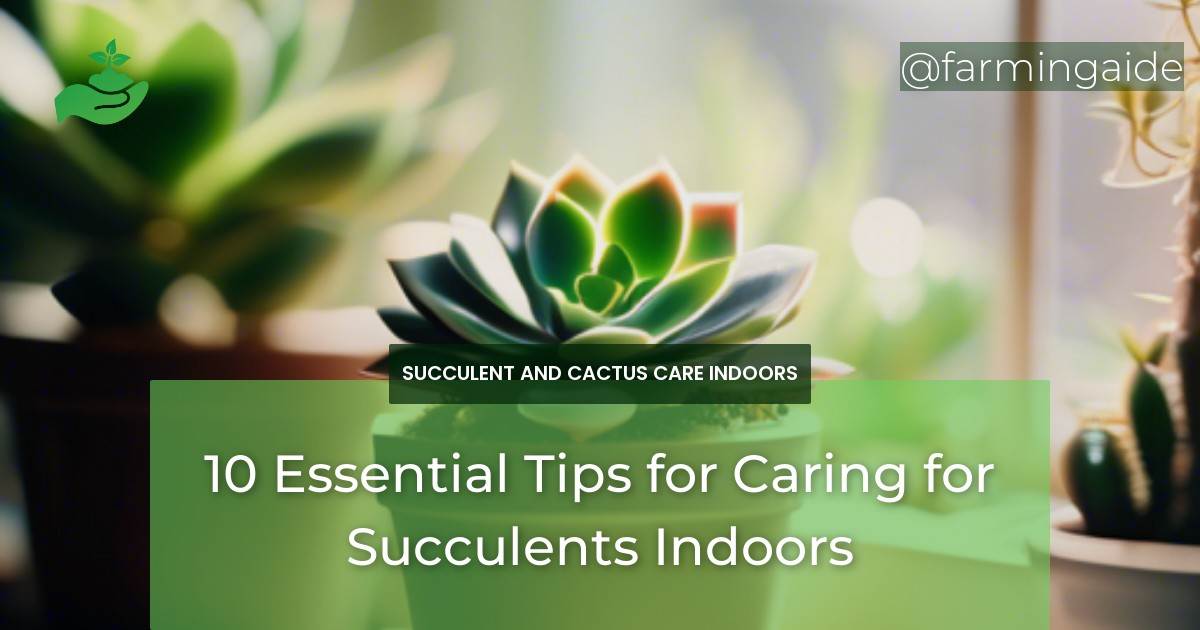Welcome to the world of succulent care! If you’re new to indoor gardening, succulents are an excellent choice for beginners. They’re low-maintenance, stylish, and can thrive in a variety of environments. However, to keep your succulents happy and healthy, you’ll need to provide them with the right care. In this article, we’ll dive into the 10 essential tips for caring for succulents indoors, covering everything from understanding succulent types to decorative ideas for display.
Key Takeaways
- Choose the right succulent type for indoor growth
- Provide sufficient light, but avoid direct sunlight
- Water sparingly, and avoid overwatering
- Fertilize during the growing season
- Repot your succulents annually
- Monitor for pests and diseases
- Prune regularly for shape and propagation
- Select the right soil and pot
- Combine succulents with other plants for a unique display
- Learn to identify signs of underwatering and overwatering
Understanding Succulents
Succulents are a diverse group of plants that have adapted to survive in dry, water-scarce environments. They store water in their leaves, stems, or roots, allowing them to thrive in conditions that would be hostile to other plants. This unique characteristic makes them perfect for indoor gardening, as they can tolerate neglect and require minimal care.
With over 60 plant families and thousands of species, succulents come in a stunning array of shapes, sizes, and colors. From the delicate, lace-like foliage of the Crassula to the towering, columnar stems of the Euphorbia, there’s a succulent to suit every style and preference.
Types of Succulents Suited for Indoors
Not all succulents are created equal when it comes to indoor growth. Some popular species for indoor cultivation include:
- Aloe Vera
- Echeveria
- Crassula
- Kalanchoe
- Peperomia
Unique Characteristics of Succulents
Succulents have several unique characteristics that set them apart from other plants:
- Water storage organs (leaves, stems, or roots)
- Waxy, thickened cuticles to prevent water loss
- Stomata that can open and close to regulate gas exchange
- CAM (Crassulacean Acid Metabolism) photosynthesis in some species
Ideal Indoor Environment for Succulents
To create an ideal environment for your succulents, you’ll need to consider several factors:
ALSO READ
Light Requirements
Succulents generally require bright, indirect light to photosynthesize and thrive. However, direct sunlight can be detrimental, causing:
- Leaf scorch
- Color fading
- Overheating
Aim for 4-6 hours of indirect sunlight per day, or use grow lights as a supplement.
Temperature and Humidity
Succulents prefer daytime temperatures between 65°F (18°C) and 75°F (24°C), with a 5-10°F (3-6°C) drop at night. Humidity levels should be maintained between 40-60% to prevent water loss and root rot.
Watering Techniques for Succulents
Watering is the most critical aspect of succulent care. Overwatering is the most common cause of death in these plants, so it’s essential to get it right:
ALSO READ
Frequency and Amount of Water
Water your succulents when the soil is dry to the touch, usually every 7-10 days in the spring and summer, and every 4-6 weeks in the fall and winter. Water sparingly, as excess moisture can lead to root rot.
Signs of Overwatering and Underwatering
Monitor your succulents for signs of:
- Overwatering: soft, mushy leaves; black or brown spots; fungal infections
- Underwatering: wrinkled, shriveled leaves; slow growth; leaf drop
Soil and Fertilization
The right soil and fertilizer can make a significant difference in your succulent’s health and growth:
Best Soil Mix for Succulents
Choose a well-draining potting mix specifically designed for cacti and succulents. Avoid using regular potting soil, as it can retain too much water and cause root rot.
Fertilizer Types and Application
Feed your succulents during the growing season (spring and summer) with a balanced, water-soluble fertilizer. Dilute the fertilizer to half the recommended strength to avoid burning the roots.
Potting and Repotting Succulents
Potting and repotting are crucial for maintaining healthy succulents:
Choosing the Right Pot
Select pots with good drainage holes to prevent waterlogged soil. Terra cotta pots are an excellent choice, as they allow for better airflow and moisture evaporation.
Signs It’s Time to Repot
Repot your succulents annually or bi-annually to provide fresh soil and a larger pot if necessary. Look for signs such as:
- Soil depletion
- Root bound
- Slow growth
Common Pests and Diseases
Regularly inspect your succulents for signs of pests and diseases:
Identifying and Treating Pests
Common pests include:
- Mealybugs
- Spider mites
- Aphids
Treat infestations with insecticidal soap or neem oil.
Preventing Diseases
Fungal diseases can be prevented by:
- Avoiding overwatering
- Providing good air circulation
- Removing infected plants
Pruning and Propagation
Pruning and propagation are essential for maintaining shape, promoting healthy growth, and creating new plants:
How and When to Prune
Prune your succulents during the growing season to:
- Maintain shape
- Promote new growth
- Remove dead or damaged leaves
Propagation Methods
Propagate succulents through:
- Leaf or stem cuttings
- Division
- Seed germination
Decorative Ideas for Indoor Succulents
Get creative with your succulent display:
Succulent Arrangements and Displays
Create stunning arrangements using a combination of succulent species, textures, and colors.
Combining Succulents with Other Plants
Mix and match succulents with other plants, such as air plants, mosses, or ferns, to create a unique and visually appealing display.
Conclusion and Final Tips
By following these 10 essential tips for caring for succulents indoors, you’ll be well on your way to becoming a succulent expert. Remember to:
- Monitor and adapt to your succulent’s needs
- Experiment with different species and arrangements
- Share your knowledge and learn from others in the succulent community
Happy planting, and happy succulent-ing!


